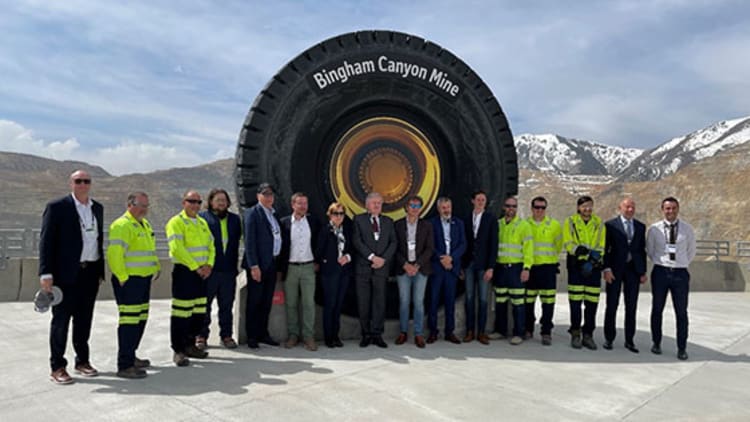Somewhere outside of Milford, Utah, the lawmakers aboard the “Energy Tour” bus were getting restless.
They left Salt Lake City in the early hours of the morning to tour the state’s west-desert energy corridor. Now, hours later, they were over 200 miles from where they started, bumping over back roads in rural Utah.
“This might have been a little too ambitious,” Utah Rep. Steve Handy said.
Some of the group had already traveled far: members of the parliament of Wallonia, the French-speaking region of southern Belgium. NCSL and the Utah Legislature, through a grant from the U.S. State Department, organized a policy and cultural exchange to bring the Belgians to the U.S. to learn about state and federal energy policy, the transition from fossil fuels to low-carbon sources, and federalism. A group of U.S. legislators toured Belgium to learn about similar topics in early 2020, but due to COVID-19 travel restrictions, reciprocity had to wait until this spring.
“We had just a great experience in Belgium and were treated so graciously that I was anxious to showcase my state and hopefully give them guidance on possible solutions to their energy challenges,” Handy said.
Utah presented a unique opportunity to showcase those concepts to the Wallonia delegation. The state has a robust energy sector that includes both traditional fossil resources along with new and innovative clean energy resources.
First Stop: Intermountain Power Project
The huge, 13-story generating facility in Delta, Utah, sits on about 4,600 acres and began operations in the mid-1980s. Historically, the plant has been powered by two 950 megawatt coal generating units and provides electricity to Southern California. (Fun fact: Utah coal powers Disneyland!) However, that is about to change. The facility will transition to natural gas in 2025 and later to hydrogen gas.
Jon Christensen, vice president of the Intermountain Power Service Corp., told the group the transition was well underway. He cited advancements in hydrogen technology and demand for low-carbon energy from California as major motivating factors for phasing out coal power. The delegation saw the equipment and process involved with transitioning from coal to clean power.
From the plant’s rooftop, the delegation took in views of the rest of the facility, including the on-site reservoirs and the entrances to underground salt caverns that will one day be used to store hydrogen gas.
Next stop: Milford, Utah
The town, with a population of 1,400, is home to the “Milford Energy Corridor,” a collection of facilities situated in a beautiful high desert valley. Milford’s elevation at a little more than 4,900 feet above sea level and its location make it ideal for both wind and solar development. At the Milford Wind Corridor Project, which operates a wind and solar facility north of town, the delegation learned about the interaction of federal, state and local governments required to build and operate the facility.
The Milford Energy Corridor also includes a facility that collects methane from more than 250,000 hogs and converts it into natural gas, and the Blundell Geothermal Plant, which converts the earth’s natural heat to energy. Utah’s geology makes it a prime location for geothermal energy development, and Blundell, which has been in operation since 1984, was one of the first such commercial plants in the U.S.
The nearby Frontier Observatory for Research in Geothermal Energy project, also known as FORGE, is a research project conducted in partnership with the U.S. Department of Energy. It has provided significant breakthroughs in demonstrating technology and techniques that can be used in geothermal development.

Last Stops
At the Kennecott Copper Mine (formally known as the Bingham Canyon Mine) southwest of Salt Lake City, the Wallonia delegation heard from officials about efforts to reduce the mine’s carbon footprint and the role of rare earth minerals in energy production. A stop at the electric vehicle laboratory at Weber State University in Ogden, about 40 miles north of Salt Lake City, included an overview of vehicle production and the university’s efforts to train the next generation of EV workers—a major issue in the European Union’s energy transition.
In addition to the tour of energy sites, the delegation met with Utah Lt. Gov. Deidre Henderson and a bipartisan group of legislators, including Sen. Jacob Anderegg and Reps. Karen Kwan and Tim Hawkes. The visitors toured the Capitol and heard presentations from energy developers about the challenges and opportunities presented by the transition to clean energy sources.
The tour concluded with stops at two of Salt Lake City’s most prized attractions: Temple Square, for a rehearsal of the Mormon Tabernacle Choir, and Vivint Arena, home of the Utah Jazz. The delegation got to hang out in the players’ locker room where they were impressed by Rudy Gobert’s size 20 shoes.
“It was an epic week, and NCSL’s staff, along with our staff at the Utah House of Representatives, provided incredible logistical support,” Handy said. “The Belgians are lovely people who face significant challenges in energy policy, and hopefully, we were able to assist them developing policies that will provide their citizens with a bright and more stable energy future.”
Christopher McMichael is a policy associate in NCSL’s Environment, Energy and Transportation Program.